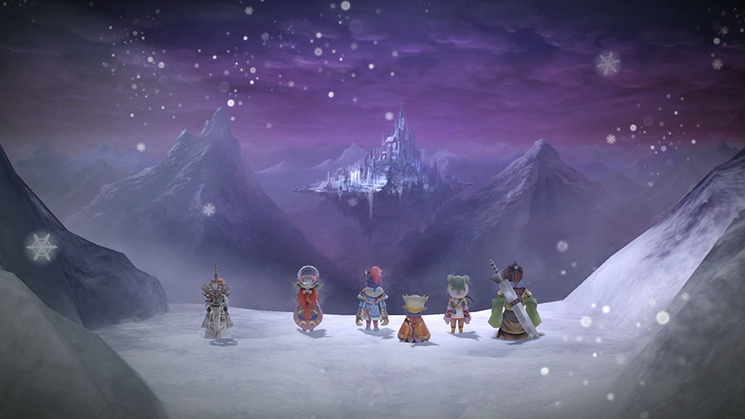In January, on my quest to finish more games in 2018, I played through Metroid: Samus Returns on the 3DS and I Am Setsuna on the Nintendo Switch. While they are both throwbacks to the 1990s, the games are not similar. Metroid: Samus Returns is a side-scrolling action-platformer with deep puzzling and exploration. It is technically a re-imagining of the Game Boy’s Metroid II: Return of Samus, but it’s really more of a spiritual successor to the SNES classic, Super Metroid. I Am Setsuna is a top-down turn-based RPG, reminiscent of Square’s SNES era games, with a heavy nod to Chrono Trigger. Despite their incompatible play-styles, in my determination to play them both to the end, I found a deeper understanding of the roadblocks and challenges that games in general are designed to offer. At their best, games force us to struggle, maybe learn, and then reward us with a feeling of accomplishment when we overcome a tough obstacle. At their worst, they provide a sense of frustration that gives way to boredom, ultimately leading to giving up, or simply forgetting to continue. What follows is an examination of why I finish so few games. And I suspect it might not just be me.
I’m going to highlight three characteristics that help us see a game through to its end. First, a game has to give us a sense of progress, whether that’s through a narrative story arc or a series of challenging levels, it’s all the same. We have to be working toward something. Second, a game has to maintain a sense of novelty. I think the downfall of many modern, sprawling open-world games is that we drown in repetitive tasks. At some point, those icons on the word map, whether it’s in Assassins’ Creed, Horizon, or Far Cry, they start to look like chores and do not inspire me to continue playing. It’s a tightrope that developers have to walk, balancing a perceived demand for bigger, longer experiences against the finite list of ‘things to do’ in any given game. And third, a game has to keep a balanced level of challenge. A drastic change in difficulty, whether it’s a punishing difficulty spike or an over-powered character making everything a walk in the park, they both detract from the experience and make me start thinking of other games I’d rather be playing.
Each of these elements work in concert with the others, and they can be weighted differently in different types of games. Picture a platform held up by three posts. The posts can be equally distributed, or maybe one of them is a big solid pillar in the center, but one way or another, they have to be arranged in a manner that will hold the platform up. Those big, open-world games I mentioned live and die by the strength of their stories, because their novelty is guaranteed to wear off by hour 60. Games like Geometry Wars or Pac Man have no story at all, and nothing novel to offer once you grasp their simple gameplay mechanics, but they give a huge feeling of progress as you improve your own reflex skills. Your own high score is a constant and organic challenge to face. The elements may present themselves differently from game to game, but they are at the core of every game experience. When you find yourself tiring of a game, or think you’d rather be playing something else, or not playing at all, it is probably because one or more of these three elements is out of balance. The posts aren’t supporting the platform.
Metroid: Samus Returns gives a great sense of progress. The classic Metroid formula of exploring an area, observing impassable obstacles, and eventually finding or earning a tool to then pass said obstacles, is still the framework here. It is further gamified by an actual counter checking down your progress toward the next area. Samus is there to eliminate Metroids, 40 of them to be exact, and you always know how many you have left to hunt.

Another classic characteristic of a Metroid game is, for better or worse, backtracking. This is usually a result of the aforementioned obstacles being presented before you have the tool necessary to pass it. But the backtracking in Samus Returns is mitigated by clearly delineated areas, basically levels, that, again, tell you exactly how many Metroids to hunt before the next area will open up. I kept expecting to have to return to a previous area, unlock a formerly un-unlockable door, and then return to my point of furthest progress. But it never really happened that way. There are hidden items to go back for, but nothing essential. And I found my Samus to be adequately powered up just by digging through each area a bit. I always had enough missiles and energy tanks when I met the more challenging bosses. Within each level, the experience retains the feeling of a classic Metroid, but Samus Returns also has an overall more linear sense of progression as you clear the requisite number of metroids from one area, then move on to the next.
Moving on to the next area always maintained the sense of novelty. Generally, I had just acquired a new tool of some sort, whether it was a new weapon like super missiles or a beam upgrade to shoot through walls, or a movement tool like a grappling hook or the ability to run underwater. I always had a new toy to play with. It’s impressive how they packed such a big toolkit into the 3DS’s limited controls. By the end I was using every button and the touch screen, all in complex combinations, and it always felt graceful. And each new area was visually diverse as well. There was some environmental storytelling, although, to be fair, there’s not much story here. There’s a bounty on 40 metroids, and Samus is there to claim it. That’s about it. Yet even the metroids themselves manage to stay interesting. They’re each essentially puzzle bosses, but every time I felt I had their move-sets down and could tackle them easily, the next one would be an evolution, and I’d have to learn a different encounter. It took me about 20 hours to see the credits roll. That’s pretty long for this style of game, and I’d be lying if I said I wasn’t starting to feel fatigued by the end of it, but I never once felt like I didn’t want to continue. Just as my interest was starting to wane, I knew I was nearing the finish line, and I pushed on.
Some of the later encounters are very challenging. There’s a boss fight with a giant harvester machine that took me a few play sessions to wrap my head around. I couldn’t figure out how to do any damage, and I knew I was missing something obvious. It was the only point in the game that made me consider going to the internet for guidance. I’m glad I resisted. The solution came to me while I was at work. When I was able to get back to the game, I tested my hypothesis, and I was right. Then I had the pleasure of practicing the mechanics of my plan until I was able to actually pull it off. The test was a perfect combination of puzzle and skill, and it felt like it was tuned just for me. Just as I was at my wit’s end, I was able to best it. The difficulty curve in Metroid: Samus Returns is on par with other masterpieces like The Witness, or, more recently, Celeste. It’s a rare thing in games, hard enough to feel like an accomplishment, but not so hard that frustration causes you to either quit or look up the answers. I cherish those moments in gaming. The final boss of Samus Returns was, appropriately, the most difficult by far. For fans of the series, those last moments are a perfect segue to Super Metroid, which follows chronologically.
Metroid: Samus Returns is a rare example of a game that balances its platform evenly on the three posts. It constantly rewarded me with a sense that I was moving forward. It consistently iterated on itself in new and surprising ways. And it repeatedly brought me to the edge of beating my head against the wall in frustration, yet I was always able to succeed on my own terms, using my own wits and skill.
I Am Setsuna also took me about 20 hours to complete, but my enjoyment of the game ended far earlier. Truth be told, if it wasn’t for the purposes of this article, I would never have seen the end of the game. Which is a shame, because most of its best elements are buried in the back end. In fact, I Am Setsuna has a robust set of ‘end-game’ like activities that I will probably never bother to go back for, but it’s at least interesting to know they’re there. The game is not terrible. There is a lot to enjoy in I Am Setsuna, but not enough to make me want to keep playing it. And that makes it a perfect subject for the Progression-Novelty-Challenge test.
Role-playing games generally attempt to tell a story, so it’s natural that your sense of progression is tied to the narrative. I Am Setsuna has an interesting set up. Your party starts with Endir, a masked mercenary, and he accepts a contract to kill a young woman, Setsuna. The rub here is that Setsuna is already fated to die. She has been selected to be her generation’s Sacrifice, an offering to an unknown entity that appeases the monsters roaming the land. So Endir can actually fulfill his duty by escorting Setsuna on her pilgrimage, making sure she also fulfills her duty. Of course, things can never be quite so simple. The story that follows is the most successful part of I Am Setsuna. There are some formulaic beats and tropes, but all in all, I thought it was very good. But it’s not enough to support the game on its own.
Ideally, an RPG’s story masks a series of systems and tasks that gamify the experience. I Am Setsuna has plenty of systems in place. There are characters to meet and add to your party. Each character has a specific weapon type, and you’ll find progressively stronger examples of them all. There are spells, or Spritnite, to obtain, some for specific characters, as well as some general spells that can be equipped by anyone. These Spritnite are slotted into Talismans, that can also be equipped by everyone, but offer unique bonuses that might be more suited to one class type over another. There are materials to upgrade a weapon that may seem obsolete, as weapons might have a unique ability, like elemental attacks or replenishing magic points on critical hits, even though you’ve moved past the weapon’s base stats. But I never felt the need to bother. Unfortunately, the systems here are disjointed and obtuse, and honestly, I managed to complete the game without ever fully understanding a few of them. If someone wants to shed some light on the Fluxation system, the comments are open.
For the reasons listed above, even when the game introduced new and novel features, none of them felt tied to my progress. While Metroid gradually introduced mechanics that became essential to my progress in the game, I Am Setsuna buried me in systems early on, but I quickly found a few abilities and spells with which I could easily win any encounter. Later on, I purposefully tried out other techniques, and while it was fun, it was completely unnecessary. By the time I understood that defeating enemies in different manners caused different materials to drop which in turn opened up different Spritnite for me to obtain, I was over it.



I Am Setsuna fails to maintain novelty in another, more egregious way, specific to RPGs. It always looks the same. In a small game like this, I can forgive a small setting, but the snowy, winter scenery that opens the game is the only kind you’re going to get. Every town you visit is basically the same. Worse, the dungeons have little variety. Early on, they might present as caves or forests or mountain paths, but by the end they are all stripped down techno-fantasy paths of light, identical to each other in every way. The lack of décor in the later dungeons actually highlights that the earlier dungeons were just the same mazes, but with some nature dropped over them.
As I said earlier, there is actually end game content in this little single player RPG. Late in the game, your party will gain the ability to quickly travel the world. Very, very late in the game. I hopped around and found islands I couldn’t have possibly accessed before that point. It turns out that each character in your party has a personal quest, and upon completing those quests, you’re rewarded with their Legendary Spritnite. These quests unlock only once you have access to the final boss fight. A new, and quite interesting, character is added to your party at that point as well. There was even an asynchronous multiplayer Temporal Battle Arena added after launch. It allows you to upload your party data, and you can do battle against AI controlled renditions of other people’s uploaded data. But only after you’ve completed the main game. I bring all of this up because it really magnified, for me, how tired I was of playing I Am Setsuna. I just wanted to see the credits roll and be done. Maybe one day I’ll go back to the stuff I had unlocked, but I doubt it.
And lastly, I Am Setsuna fails to balance its difficulty. It is mostly a cake walk. Then an enemy suddenly 1-hit wipes your entire party. Two instances in particular almost made me walk away completely. First, there was an enemy that continued to heal himself so thoroughly that the fight was unwinnable. I ended up having to resort to the internet, where I learned of an ability to counter this, one that I hadn’t experimented with. From what I could find, it is the only tool at your disposal to win this encounter, and I Am Setsuna never requires it elsewhere, nor did it encourage me to experiment on my own enough that I would discover it naturally. Second, the game uses a save point system in its dungeons, but the final dungeon has none. The last battles of that last dungeon defeated me more than a few times, forcing me to replay a long segment multiple times. ‘Git Gud,’ I know, but make me want to, please. I Am Setsuna did not.
While I did enjoy watching the story unfold throughout I Am Setsuna, that just wasn’t enough to support my enjoyment for 20 hours. There was too little to keep me interested in the gameplay systems, and the frustrating spikes in difficulty actually worked against me.
In playing Metroid: Samus Returns and I Am Setsuna side by side, determined to finish both games before I moved on to anything else, I learned about what I love about video games. I was tempted to put both of them down at different points, but with Metroid, I always knew I would come back to it, while with I Am Setsuna, it was a self-imposed chore. I think the fact that they are so different from each other mechanically allowed me to distill my impressions, to expose some universal anchors that all games should have. I know that in the future, when a game starts to feel stale, I can examine my own sense of progress, the game’s continued novelty, and how well its difficulty is balanced. At least then I might know why it’s time for me to play something else.
What do you think? Do you tend to finish games? Or do you move on as soon as you’re bored? Let me have it in the comments. Bookmark this site and follow me on Twitter, and I’ll let you know what I’m not finishing lately.



I definitely don’t finish most of my games. Whether that’s because I got bored, there was too much challenge and frustration or there was something else shiny and new to look at.
I find the idea that you can balance a game appropriately for everyone or even your general audience to be constantly engaging especially baffling. It’s such a hard thing to do. The ideal case for players is to have them in a flow zone, but what allows someone to be in and maintain flow constantly changes based off the game and the player’s environment.
If you haven’t had a chance yet I’d highly recommend checking out Jenova Chen’s thesis on flow in games and subsequently his game ‘flow’. http://www.jenovachen.com/flowingames/
LikeLiked by 1 person
I completely agree. Attempting to balance a game for everyone is a fool’s errand. Even trying to predict your target audience’s engagement levels is rough, (although hopefully the creator finds it compelling enough to share.)
But since writing out the thoughts in this post, I keep coming back to those three tenets– progression, novelty, and challenge. Whenever my interest starts to wane, I check myself for how I’m feeling about those elements in relation to the game. If anything, it helps me understand what a game may have been doing well to hold my interest until that point. Maybe it’s my way of thinking of flow in the long term, as opposed to the flow of minute-to minute gameplay.
I loved Journey, but have not seen more of Jenova Chen’s work. Thanks for the link! He was on one of my favourite episodes of IGN Unfiltered with Ryan McCaffery. A really beautiful interview… Here’s a link if you’re interested.
https://ca.ign.com/articles/2018/01/30/journey-flower-and-sky-creator-jenova-chen-a-ign-unfiltered-27
LikeLike